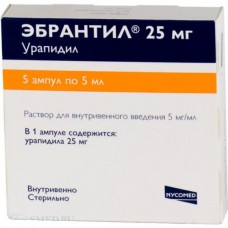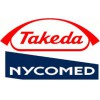Expiration date: 10/2025
Structure and Composition:
Solution for intravenous administration. 1 ml contains: urapidil hydrochloride 5.47 mg (Corresponds to 5.0 mg urapidil)
Excipients: sodium hydrogen phosphate dihydrate, propylene glycol monosodium phosphate dihydrate Water for Injection
ampoules with breaking point and marking strip of 5 or 10 ml pack strip cellular 5 ampoules in a cardboard box 1 pack.
Description pharmaceutical form:
The clear, colorless solution.
Pharmacokinetics:
After the on / in the 25 mg urapidil biphasic observed reduction in the concentration of the drug: first - the rapid decline (alpha-phase), and then - the slow (beta-phase).
Allocation period of the drug is about 35 minutes.
The volume of distribution - 0.8 l / kg (0.6-1.2 l / kg). Most of urapidil is metabolized in the liver. The major metabolite - hydroxylated in the 4-position of the benzene ring of derivative which has virtually no antihypertensive activity.
O-demethylated metabolite produced in very small quantities and practically also active as urapidil. 50-70% urapidil and its metabolites (15% - as the active drug) excreted by the kidneys, and the rest is output through the intestine as metabolites (mainly as an inactive paragidroksilirovannogo urapidil).
T1 / 2 after i / v bolus of 2.7 hours (1.8 -3.9 hours). Binding to plasma proteins - 80%. The relatively low degree of binding to plasma proteins minimizes the likelihood of interaction with the drug urapidil, strongly bound to plasma proteins.
In elderly patients and in patients with severe hepatic and / or renal insufficiency, volume of distribution and clearance of urapidil reduced and T1 / 2 is increased.
Urapidil penetrate the BBB and placental barrier
Description of the pharmacological actions:
Ebrantil refers to drugs that block postsynaptic alpha1-adrenergic receptors, thereby reducing peripheral resistance. In addition, Ebrantil drug controls the central mechanism for maintaining vascular tone and has a weak beta-adrenoceptor blocking action. Heart rate, cardiac output when administered not change. Low cardiac output can be increased by reducing vascular resistance. Orthostatic effects usually Ebrantil drug causes. Blocks vasoconstriction caused by the alpha2-adrenergic receptors, and does not cause reflex tachycardia due to vasodilation. The drug Ebrantil balanced reduces systolic and diastolic blood pressure by reducing peripheral resistance.
Urapidil reduces pre- and afterload on the heart, increases the efficiency of cardiac contraction, thereby, in the absence of arrhythmia, drug increases cardiac output decreased.
Mechanism of action
The drug has Ebrantil central and peripheral mechanisms of action.
Advantageously, the peripheral blocks postsynaptic alpha 1 adrenergic receptors, thus, the drug blocks the vasoconstrictor effects of catecholamines. In the CNS, urapidil affects the vasomotor center activity, which is manifested in the prevention of reflex changes in sympathetic tone.
Urapidil not affect carbohydrate metabolism, the exchange of uric acid and does not cause water retention.
Indications:
- hypertensive crisis
- refractory hypertension or severe degree of severity
- controlled hypotension during and / or after surgery.
Contraindications:
- Hypersensitivity to the drug
- aortic stenosis
- open arterial canal
- pregnancy
- Lactation (effectiveness and safety have been established)
- children's age (18 years).
Carefully:
- elderly age
- liver and / or kidney disease
- hypovolemia.
Side effect:
Most of the following side effects due to a sharp drop in blood pressure, but the clinical application experience shows that they disappear for several minutes even after the drug Ebrantil drip infusion. Severe side effects may require discontinuation of treatment.
Drug Interactions:
The antihypertensive effect may be enhanced when urapidil joint reception with alpha-blockers and other antihypertensive agents, as well as hypovolemia (nausea, vomiting), and upon receipt of ethanol.
At the same time taking cimetidine urapidil Cmax in blood plasma can be increased by 15%.
Dosage and administration:
In / in, bolus or by continuous infusion (lying).
Hypertensive crises, severe degree of hypertension, refractory hypertension
1. B /: 10-50 mg Ebrantil drug slowly introduced in / under the control of blood pressure. Lowering blood pressure expected within 5 minutes after administration. Depending on the therapeutic effect of possible re-introduction of the drug Ebrantil.
2. B / drip or a continuous infusion using a perfusion pump: maintenance dose - an average of 9 mg / h, ie, Ebrantil 250 mg of the drug (10 to 5 ml ampoules or 5 ml ampoules of 10) in 500 ml of infusion solution (1 drop = 44 mg = 2.2 ml).
The maximum allowable ratio - 4 mg Ebrantil 1 ml solution for infusion.
The recommended maximum initial velocity - 2 mg / min.
Speed ??drip depends on the performance of AD patients.
The solution for the drip infusion, intended for the maintenance of blood pressure, is prepared as follows:
Typically, 250 mg (10 5 ml ampoules or 5 ml ampoules 10) Ebrantil preparation was added to 500 ml of a solution for infusion (e.g. physiological saline or 5 to 10% dextrose (glucose).
If administration maintenance dose using a blood pump, then 100 mg (4 ampoules of 5 ml or 2 ampoules of 10 ml) of the drug Ebrantil introduced into the blood pump syringe and diluted to 50 ml with physiological saline, 5 or 10% dextrose (glucose) .
Guided (controlled) reduction of blood pressure when it is increasing during and / or after surgery
Continuous infusion via perfusion or drip infusion pump is used to maintain the blood pressure at the level achieved by intravenous administration.
Drawing. Driving Ebrantil dosing of the drug.
Remarks:
- If the previously used other antihypertensives topreparat Ebrantil can be introduced only after a time sufficient to act (s) previously introduced (e) product (s). The dose should be adjusted accordingly Ebrantil
- Using antihypertensive drugs in elderly patients should be cautious. The initial dose should be reduced compared with the recommended because elderly patients sensitivity to drugs such a series are often changed (reduced volume of distribution, and T1 / 2 is increased).
The introduction of the drug can be single or multiple. Injecting the drug can be combined with a subsequent drip infusion. Parenteral therapy can be repeated with the new increase in blood pressure.
Overdose:
Symptoms: dizziness, orthostatic collapse, fatigue, lethargy.
Treatment: a sharp drop in blood pressure is necessary to raise the patient's leg and begin infusion therapy to increase BCC. With the ineffectiveness of these measures can begin infusion of vasoconstrictor controlled blood pressure. In very rare cases it is necessary to / with the introduction of catecholamines (0.5-1.0 mg epinephrine (adrenaline), diluted in 10 ml saline).
Special instructions:
The simultaneous use of other antihypertensive agents appointed interior.
No clinical data on the use of the drug in children under 18 years.



